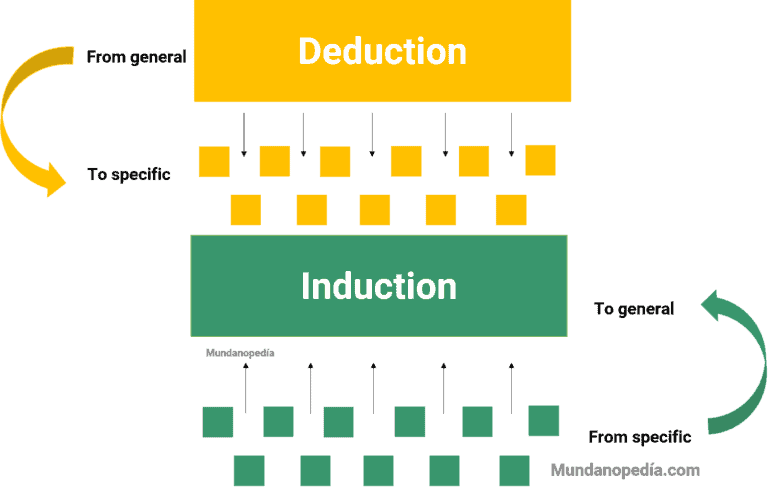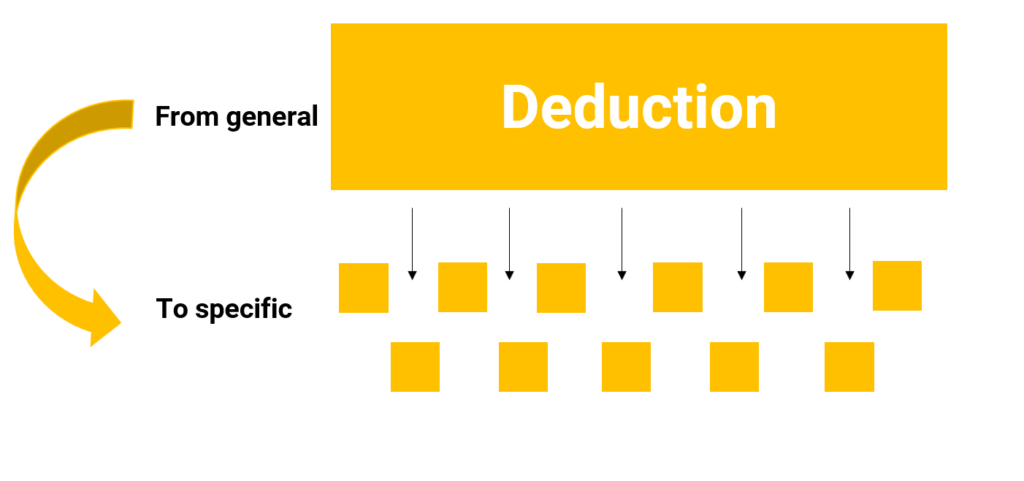Deductive and Inductive Reasoning: Definition, Differences & Examples

Human beings navigate the complexities of the world and make sense of reality through two key cognitive processes: deductive and inductive reasoning. These methods, though distinct, work together to empower our understanding.
Inductive reasoning follows a bottom-up approach. We begin by meticulously gathering specific observations and accumulating empirical evidence. By analyzing these particular cases, we can identify patterns and formulate general conclusions.
Deductive reasoning, on the other hand, operates in a top-down manner. It relies on established general principles or accepted theories. We apply these broad ideas to specific situations to arrive at logical conclusions.
By employing both inductive and deductive reasoning, we gain a comprehensive understanding of the world. We can not only glean insights from observations but also utilize existing knowledge to solve problems and make well-informed decisions.
Contents
Inductive reasoning
The inductive method revolves around making general conclusions based on specific observations. It involves starting with a series of established facts that undergo systematic analysis and comparison to arrive at a general principle. This method essentially progresses from specific instances to a broader generalization.
For example, imagine observing that mosquitoes seem to disperse whenever your neighbor turns on their garden light at night. Based on these repeated observations, you might inductively conclude that light may be a deterrent for mosquitoes.
In his work, “Novum Organum,” Francis Bacon proposed the inductive method as an alternative to traditional deductive reasoning. Bacon argued that the deductive approach, which relies on established logic and reasoning from general principles, has limitations in uncovering new knowledge and driving scientific progress.
In contrast, Bacon championed induction as the most effective path to acquiring knowledge and understanding nature. He proposed that induction involves observing and collecting specific data from experience. This data is then generalized from to establish broader conclusions.
Steps of Inductive Reasoning
The inductive method follows a series of stages or steps to arrive at a general conclusion. The main stages of the inductive method are as follows:
- Observation: Detailed and systematic observation of specific phenomena or cases is conducted. Relevant information is collected and recorded objectively.
- Identification of patterns and trends: Based on the observation, patterns, trends, or regularities in the data are identified. Similarities and differences among the observed cases are sought.
- Formulation of hypotheses: Researchers formulate general hypotheses or assumptions that explain the observed phenomena, building on the identified patterns and trends.These hypotheses are tentative and need to be subjected to further testing.
- Gathering more evidence: Researchers collect additional evidence and data to support or refute the formulated hypotheses. They may conduct experiments, carry out further studies, or gather more relevant information.
- Analysis and generalization: The collected data and evidence are rigorously analyzed. Based on this analysis, generalizations are made, and broader conclusions are drawn that apply to a larger population or context.
- Verification or hypothesis confirmation: The obtained inductive conclusions undergo verification and review. Researchers seek to confirm their validity by repeating observations and conducting additional testing. If necessary, they adjust the conclusions or formulate new hypotheses.
Examples of inductive reasoning
Example 1: Steps of induction
Here’s a simple example that illustrates each step of the inductive method:
- Observation: You observe that every time you water your plants with mineral water, they grow faster and appear healthier compared to when you water them with tap water.
- Patterns and trends: Through continuous observations, you notice that this pattern consistently repeats in different plants and at different times.
- Formulation of hypothesis: Based on the observed patterns, you formulate the hypothesis that mineral water may have a positive effect on plant growth and health.
- Gathering more evidence: You decide to conduct an experiment where you water one group of plants with mineral water and another group with tap water. Over a period of time, you record the growth and health of the plants in both groups.
- Analysis and generalization: Upon completing the experiment, you analyze the data and find that the plants watered with mineral water have shown faster growth and a healthier appearance compared to the plants watered with tap water. Based on these results, you generalize that mineral water may have benefits for plant growth in general.
- Verification and revision: You repeat the experiment under different conditions and with different types of plants to verify if the results remain consistent. You may also consult existing scientific studies on the topic to support your conclusions.
Example 2: Observation of outstanding students
- Specific observation: You have noticed that several students who achieve high grades in mathematics also perform well in other subjects.
- General conclusion: There is a correlation between outstanding academic performance in mathematics and outstanding academic performance in other subjects.
Example 3: Observation of animal behavior
- Specific observation: You have observed that every time you throw a ball, your dog retrieves it and brings it back to you.
- General conclusion: Dogs have the ability to learn and respond to commands to retrieve objects.
Example 4: Observation of consumption habits
- Specific observation: You have noticed that many people in your neighborhood purchase organic products and avoid processed foods.
- General conclusion: There is a growing preference for organic foods and increased awareness of the importance of healthy eating in the community.
Deductive reasoning or deduction
The deductive method involves deriving specific conclusions from a general premise or hypothesis. The deductive method moves from the general to the specific. For example, “All human beings have a heart and a brain, I am a human being, therefore I have a heart and a brain.”

Steps of deductive reasoning
The deductive method follows a series of stages or steps to arrive at specific conclusions from general principles. The main stages of the deductive method are as follows:
- Establishment of premises: Initial premises or general principles that are considered true are established. These premises are accepted as true and serve as the basis for deductive reasoning.
- Application of logical rules: Logical rules, such as modus ponens or modus tollens, are applied to infer specific conclusions from the established premises.
- Deductive reasoning: A logical and systematic process is followed to reach a specific conclusion based on the established premises and applied logical rules.
- Verification of the conclusion: The deduced conclusion is verified to ensure that it is logically valid and consistent with the initial premises.
Examples of deductive reasoning
Here are some simple examples of deductive reasoning:
Example 1:
Premise 1: All birds have wings.
Premise 2: Canaries are birds.
Conclusion: Therefore, canaries have wings.
In this example, we start with the general premise that all birds have wings. Then, the specific premise that canaries are birds is established. From these premises, we reach the logical conclusion that canaries have wings.
Example 2:
Premise 1: If it rains, the street will be wet.
Premise 2: It is raining.
Conclusion: Therefore, the street will be wet
Difference and relationship between deductive and Inductive methods
The difference between the two is that the deductive method goes from the general to the specific, whereas the inductive method does the opposite, starting from specific facts to extract a general conclusion.
Regarding their relationship, although they are distinct approaches, the deductive and inductive methods are related and complement each other in scientific research. They are not mutually exclusive but rather used together because they are interconnected. The exclusive use of a single method is not sufficient for explaining the phenomena under study.
Induction can provide observations and empirical evidence that can then be used in deductive reasoning to establish more specific conclusions. On the other hand, deduction can provide general principles or theories that can be tested through induction.
Examples of the link between deductive and inductive reasoning
In the field of economics, let’s consider a country trying to explain the behavior of prices in relation to liquidity. The deductive and inductive methods can be used as follows:
Inductive method: The experts starts by using the inductive method to make broad generalizations based on specific observations. They collect data on liquidity and analyze and compare it systematically using statistical methods. Based on the observed trends, they formulate hypotheses.
Deductive method: The hypotheses formulated in the previous step are then compared with reality. Here, the deductive method comes into play. The country uses deductive reasoning to draw specific conclusions from the general premise or hypothesis. They may incorporate other theories that are considered valid, such as the quantity theory of money (which states that the general price level depends on the quantity of money in circulation), the law of demand (which states that as price increases, quantity demanded decreases; and as price decreases, quantity demanded increases), and the law of supply (which states that, holding other factors constant, the quantity supplied in the market tends to vary inversely with prices).
By combining the inductive and deductive methods, the country can form a more comprehensive understanding of the relationship between liquidity and prices. The inductive method helps identify patterns and trends based on specific observations, while the deductive method allows for the application of established theories and general principles to draw specific conclusions.
Mundanopedia has rules and high standards for creating its content and uses reliable and verified sources to support its work. These include bibliographic sources, academic research institutions, government data, original reports, and interviews with industry experts and other accredited publishers when appropriate. You can learn more about the standards we follow to produce accurate and unbiased content in our editorial policy.
- Bacon, F. (1620). Novum Organum. https://oll.libertyfund.org/title/bacon-novum-organum
- Godoy Castro, R. (1981). Teoría económica I. Universidad Nacional Abierta. https://drive.google.com/file/d/1BCBTKsdg7MHOjTPuVkYeWL2pvYTJQz2L/view?usp=sharing
- Grawitz, M. (2001) Methodology in the Social Sciences, 11th Edition, Dalloz, Paris. https://www.scirp.org/(S(vtj3fa45qm1ean45vvffcz55))/reference/ReferencesPapers.aspx?ReferenceID=1823673
- Marchal, A. (1957). Metodología de la Ciencia Económica. Buenos Aires: El Ateneo. https://catalogosiidca.csuca.org/Record/UES.134257
See also